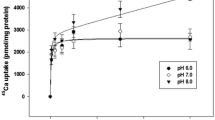Abstract
The marine macroalgaUlva sp. can take up HCO -3 via a process which chemically resembles that of anion exchange in red blood cells (Drechsler et al. 1993, Planta191, 34–40). In this work we explore the possibility that high-pK amino-acid residues could be functionally involved in the binding/transport of HCO -3 . It was found that the specific arginyl-reacting agents phenylglyoxal and 2,3-butanedione inhibited photosynthesis ofUlva competitively with inorganic carbon at pH 8.2–8.4 (which is close to the pH of normal seawater), where HCO -3 was the predominant inorganic carbon form taken up. The inhibition by phenylglyoxal was irreversible at 32°C and high pH values, while that of butanedione became irreversible in the presence of borate. These interactions, as well as the protection of the irreversible phenylglyoxal-inhibition by inorganic carbon and by the membrane-impermeant agents 4,4′-diisothiocyanostilbene 2,2′-disulfonate and 4,4′-dinitrostilbene-2,2′-disulfonate indicate that arginine (and possibly also lysine) are involved in the HCO -3 uptake process, probably at the plasmalemma level. The photosynthetic affinity ofUlva to external inorganic carbon gradually decreased with increasing pH from 8.2 to 10.5, and this decrease parallels the decline in protonation of amino acids with a pK of around 10. Based on this information, as well as the inhibition studies, it is suggested that arginine and lysine residues are essential proteinaceous constituents involved in anionic inorganic carbon (HCO -3 and possibly also CO 2-3 ) uptake into theUlva cells.
Similar content being viewed by others
Abbreviations
- AE1:
-
anion exchanger 1 (of red blood cells)
- BD:
-
2,3-butanedione
- CA:
-
carbonic anhydrase
- CI:
-
inorganic carbon
- DIDS:
-
4,4′-diisothiocyanostilbene-2,2′-disulfonate
- DNDS:
-
4,4′-dinitrostilbene-2,2′-disulfonate
- PG:
-
phenylglyoxal
References
Bar-Noy, S., Cabantchik, Z.I. (1990) Transport domain of the erythrocyte anion exchange protein. J. Membr. Biol.115, 217–228
Beer, S., Drechsler, Z., Israel, A., Cohen, Y. (1990) Photosynthesis inUlva fasciata. V. Evidence for an inorganic carbon concentrating system, and ribulose-1,5-bisphosphate carboxylase/oxygenase CO2 kinetics. Plant Physiol.94, 1542–1546
Beer, S., Israel, A. (1990) Photosynthesis ofUlva fasciata. IV. pH, carbonic anhydrase and inorganic carbon conversions in the unstirred layer. Plant Cell Environ.13, 555–560
Björk, M., Haglund, K., Ramazanov, Z., Garcia-Reina, G., Pedersén, M. (1992) Inorganic-carbon assimilation in the green seaweedUlva rigida C. Ag. (Chlorophyta). Planta187, 152–156
Border, C., Riordan, J. (1975) An essential arginyl residue at the nucleotide binding site of creatine kinase. Biochemistry14, 4699–4704
Cabantchik, Z.I., Greger, R. (1992) Chemical probes for anion transporters of animal cell membranes. Am. J. Physiol.265, C803-C827
Cabantchik, Z.I., Balshin, M., Breuer, W., Rothstein, A. (1975) Pyridoxal phosphate — an anionic probe for protein amino groups exposed on the outer and inner surfaces of intact human red blood cells. J. Biol. Chem.250, 5130–5136
Colman, B. (1984) The effect of temperature and oxygen on the CO2 compensation point of the marine algaUlva lactuca. Plant Cell Environ.7, 619–621
Drechsler, Z., Beer, S. (1991) The utilization of inorganic carbon byUlva lactuca. Plant Physiol.97, 1439–1444
Drechsler, Z., Sharkia, R., Cabantchik, Z.I., Beer, S. (1993) Bicarbonate uptake in the marine macroalgaUlva sp. is inhibited by classical probes of anion exchange by red blood cells. Planta191, 34–40
Falke, J.J., Chan, S.I. (1986) Molecular mechanisms of band 3 inhibitors. I. Transport site inhibitors. Biochemistry25, 7888–7894
Johnson, K.F. (1982) Carbon dioxide hydration and dehydration kinetics in seawater. Limn. Oceanogr.27, 849–855
Julien, T., Zaki, L. (1987) New evidence for the essential role of arginine residues in anion transport across the red blood cell membrane. Biochim. Biophys. Acta900, 169–174
Julien, T., Betakis, E., Zaki, L. (1990) Chemical properties of the anion transport inhibitory binding site of arginine-specific reagents in human red blood cell membranes. Biochim. Biophys. Acta1026, 43–50
Knauf, P.A. (1979) Erythrocyte anion exchange and the band 3 protein: Transport kinetics and molecular structure. Curr. Top. Membr. Transp.12, 249–363
Maberly, S.C. (1992) Carbonate ions appear to neither inhibit nor stimulate use of bicarbonate ions in photosynthesis byUlva lactuca. Plant Cell Environ.15, 225–260
Nanri, H., Hamasaki, N., Minakami, S. (1983) Affinity labeling of erythrocyte band 3 protein with pyridoxal 5-phosphate. J. Biotech. Chem.258, 5985–5989
Riordan, J.F. (1979) Arginyl residues and anion binding sites in proteins. Mol. Cell. Biochem.26, 71–92
Riordan, J.F., McElvany, K.D., Borders, C.L. Jr. (1977) Arginyl residues: Anion recognition sites in enzymes. Science195, 884–886
Sharkia, R., Beer, S., Cabantchik, Z.I. (1994) A membrane-located polypeptide ofUlva sp. which may be involved in HCO -3 uptake is recognized by antibodies raised against the human red-blood-cell anion-exchange protein. Planta194, 247–249
Wieth, J.O., Bjerrum, P.J., Borders, C.L. Jr. (1982) Irreversible inactivation of red cell chloride exchange with phenylglyoxal, an arginine-specific reagent. J. Gen. Physiol.79, 283–312
Zaki, L. (1983) Anion transport in red blood cells and arginine specific reagents (1) Effect of chloride and sulfate ions on phenylglyoxal sensitive sites in the red blood cell membrane. Biochem. Biophys. Res. Commun.110, 616–624
Zaki, L. (1984) Anion transport in red blood cells and argininespecific reagents: The location of14C phenylglyoxal binding sites in the anion transport protein in the membrane of human red cells. FEBS Let.169, 234–240
Author information
Authors and Affiliations
Additional information
This paper is in partial fulfillment of a Ph.D. study by R. Sharkia. Supported by the Israel Academy of Sciences, grant 441/93 (to S.B.), and by the Fund for Encouragement of Research, Histadrut, Israel (to R.S.).
Rights and permissions
About this article
Cite this article
Drechsler, Z., Sharkia, R., Cabantchik, Z.I. et al. The relationship of arginine groups to photosynthetic HCO -3 uptake inUlva sp. mediated by a putative anion exchanger. Planta 194, 250–255 (1994). https://doi.org/10.1007/BF01101685
Received:
Accepted:
Issue Date:
DOI: https://doi.org/10.1007/BF01101685




